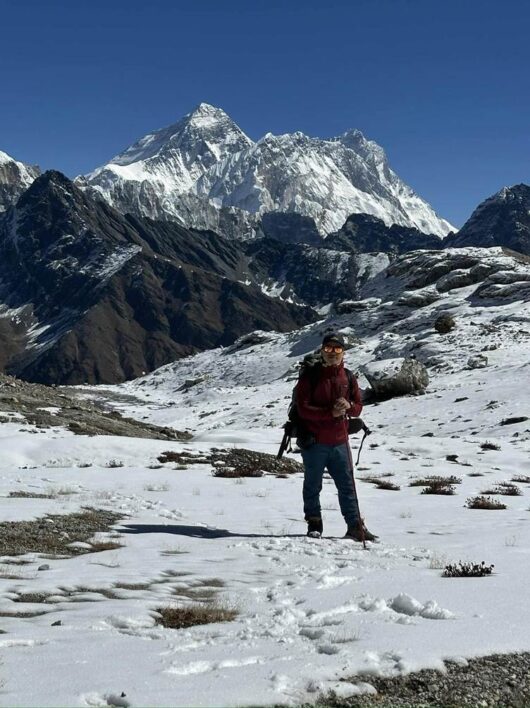The journey from Lukla to Everest is more than just a trek—it’s a cultural and spiritual pilgrimage through the heart of Sherpa country. For most adventurers embarking on Everest base camp trekking, Lukla marks the thrilling beginning of a journey toward the world’s highest peak. Perched at 2,860 meters, Lukla’s short, slanted airstrip is famous for being one of the most dramatic airports in the world. Yet, beyond the adrenaline of landing here lies something deeper: a path winding through centuries-old Sherpa villages, rhododendron forests, and the shadow of towering Himalayan giants.
The Start: Lukla to Phakding – The First Steps into Sherpa Land

Your first day on the trail sets the tone for the adventure ahead. Leaving the bustling airstrip of Lukla, the path gradually descends through quaint settlements where prayer wheels spin and yak bells echo through the pine forests. The trail to Phakding (2,610 meters) is gentle, following the Dudh Koshi River’s milky-blue waters.
You’ll pass mani walls carved with Buddhist prayers, fluttering prayer flags, and suspension bridges draped across deep gorges. Teahouses along the route offer warm dal bhat, cozy fires, and your first taste of Sherpa hospitality—a perfect welcome to the Khumbu.
Namche Bazaar: The Heartbeat of the Khumbu
Acclimatization and Exploration
After crossing several thrilling suspension bridges, including the iconic Hillary Bridge, trekkers begin the steep climb to Namche Bazaar (3,440 meters). Known as the capital of the Sherpa people, Namche is a vibrant mountain town carved into a natural amphitheater. It’s the commercial and cultural hub of the Everest region—where traders from Tibet and Nepal once exchanged salt and goods across high passes.
Namche is more than just a rest stop. It’s an essential acclimatization point for Everest base camp trekking, allowing your body to adjust to the altitude. A popular acclimatization hike takes you up to the Everest View Hotel, where you’ll catch your first panoramic glimpse of Everest, Lhotse, and Ama Dablam—three peaks that dominate the skyline and your imagination.
Sherpa Culture and Spirituality
The trail from Lukla to Everest isn’t just a physical journey; it’s an immersion into the spiritual world of the Sherpas. Their lives are guided by Tibetan Buddhism, visible in every corner—from the brightly painted chortens and monasteries to the gentle hum of monks chanting mantras at dawn.
Tengboche Monastery – A Sacred Pause
One of the most spiritual highlights of the trek is Tengboche Monastery (3,867 meters), the largest monastery in the Khumbu region. Set against the majestic backdrop of Ama Dablam, this serene complex hosts daily prayers and the colorful Mani Rimdu festival in autumn. Here, trekkers often find a moment of stillness, soaking in the profound peace that defines Sherpa life.
Visiting Tengboche also offers a chance to understand the Sherpa values of humility, resilience, and compassion—traits that have helped them thrive in this harsh yet beautiful environment.
From Forests to Frost: The Changing Landscape

As you climb higher from Namche and Tengboche toward Dingboche and Lobuche, the landscape transforms dramatically. The lush forests of rhododendron and juniper give way to alpine meadows, rocky terrain, and icy winds. The air thins, steps become slower, and every breath feels more deliberate.
The High Khumbu Region
This upper section of the Everest base camp trekking route introduces trekkers to the raw grandeur of the Himalayas. Peaks like Thamserku, Kangtega, and Pumori dominate the skyline. Villages become sparser, yet each teahouse remains a haven of warmth and comfort—a place to share stories with fellow trekkers over steaming cups of ginger tea.
Every turn of the trail reveals a new perspective: glacial rivers shimmer below, while prayer flags flutter bravely against the wind, symbolizing perseverance and faith amid nature’s extremes.
Arrival at Everest Base Camp: Standing Among Giants
Reaching Everest Base Camp (5,364 meters) is the emotional pinnacle of the journey. After days of trekking through the Khumbu Icefall’s shadow, you finally stand at the foot of the tallest mountain on Earth. The sense of achievement is overwhelming—this is where climbers prepare to challenge Everest herself.
Surrounded by jagged peaks and the Khumbu Glacier, trekkers often take a quiet moment to reflect. The journey here was not just about altitude but attitude—the patience, endurance, and respect required to move harmoniously through Sherpa land and the world’s most awe-inspiring landscapes.
Beyond Everest: The Call of Island Peak Climbing
For those who wish to go beyond trekking and experience true Himalayan mountaineering, Island Peak Climbing (Imja Tse) offers the perfect next challenge. Rising to 6,189 meters, this peak stands like an island in a sea of ice near the Imja Valley. Many trekkers who complete Everest Base Camp trekking continue toward Chhukung, where the climb begins.
Island Peak provides a hands-on introduction to technical climbing—using ropes, crampons, and ice axes—but remains accessible to fit trekkers with basic mountaineering training. From its summit, the panorama is extraordinary: Lhotse’s south face towers above, and the entire Khumbu region unfolds beneath your feet. It’s the perfect progression for adventurers who have fallen in love with the mountains and want to take their Himalayan experience one step higher.
Teahouse Life and Trekking Culture
One of the most rewarding aspects of trekking from Lukla to Everest is the unique teahouse culture that defines the region. These family-run lodges provide not just meals and accommodation but also warmth, stories, and laughter.
Evenings often unfold around wood stoves, where trekkers from around the world share experiences, Sherpa hosts exchange weather updates, and everyone savors the simple comfort of hot tea and hearty food. This human connection—alongside the mountain majesty—is what makes trekking in the Khumbu so unforgettable.
Practical Tips for the Lukla to Everest Journey
1. Best Time to Trek
The best seasons for trekking are spring (March to May) and autumn (September to November). Clear skies, stable weather, and blooming rhododendrons make these months ideal. Winter offers solitude but harsher conditions, while the monsoon season (June to August) brings rain and leeches to lower trails.
2. Acclimatization and Health
Altitude sickness can affect anyone above 2,500 meters. Follow the golden rule: “climb high, sleep low.” Take rest days at Namche and Dingboche, stay hydrated, and ascend gradually.
3. Permits and Logistics
You’ll need the Sagarmatha National Park Permit and the Khumbu Pasang Lhamu Rural Municipality Permit, both obtainable in Kathmandu or along the trail. Flights to Lukla operate from Ramechhap or Kathmandu, depending on weather and season.
4. Packing Essentials
Essential gear includes a warm sleeping bag (rated to -10°C), down jacket, trekking poles, water purification tablets, and sturdy boots. Layering is key—temperatures can shift rapidly between sunny days and freezing nights.
5. Cultural Respect
Always walk clockwise around mani walls and stupas, and ask before photographing locals or monasteries. Learning a few Nepali or Sherpa phrases—like “Namaste” or “Tashi Delek”—goes a long way in building connections.
The Emotional Journey – More Than a Trek

Every step from Lukla to Everest tells a story: of determination, reverence, and discovery. The trek is physically demanding, but it also touches something deeply human—our longing for challenge, simplicity, and meaning. In the stillness of high-altitude dawns or the laughter shared with Sherpa families, trekkers find not just the road to Everest but a path inward.
The trail, shaped by generations of mountain dwellers, teaches humility. It reminds us that these peaks, so monumental and ancient, are both humbling and healing. The Khumbu isn’t just a place—it’s a feeling that stays long after the snow has melted from your boots.
Conclusion – Walking Through the Spirit of the Himalayas
The trek from Lukla to Everest captures the essence of Himalayan adventure—raw beauty, deep culture, and the quiet wisdom of the Sherpa people. Whether your goal is Everest base camp trekking or the more daring Island Peak Climbing, each journey begins with the same first step in Lukla and unfolds into an unforgettable experience shaped by altitude, effort, and awe.
In the end, this path through Sherpa country isn’t just about reaching a destination—it’s about becoming part of a living story that continues to inspire trekkers from around the world. The mountains call, and Lukla is where the answer begins.




